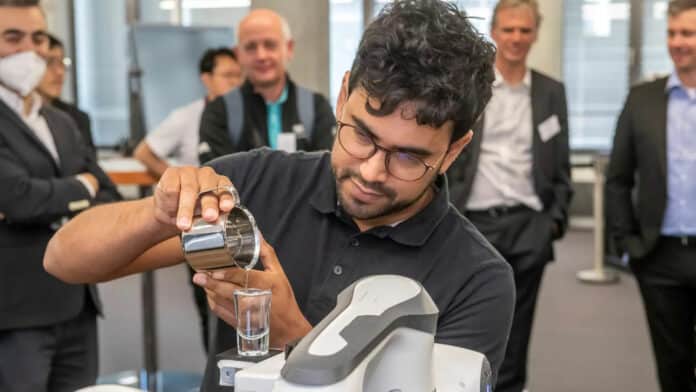The digital era has seen many formerly human-conducted jobs replaced by computers or robots, as they have made enormous advancements in their performance and capacities in recent years. Robots can perform tasks that until recently were reserved for humans: preparing food, serving tables, cleaning, delivering orders, etc. But can a robot be a better waiter than a human being?
Now, researchers at the Munich Institute of Robotics and Machine Intelligence (MIRMI) at the Technical University of Munich (TUM) have developed a model that enables a robot to serve tea and coffee faster and more safely than humans – with no sloshing.
For their study, the team sets up a robotic arm – developed by the specialized robot maker Franka Emika – on a table and hooks up a computer. The robot’s hand grips a glass filled to the brim with water, raises it, and rocks it back and forth without spilling a drop. The robot does it faster and more safely than a person, researchers say.
The team simply fed the robot with algebraic formulas that are more than 300 years old. Their mathematics is based on a Moroccan tea tray that applies the principle of a spherical pendulum.
Together with doctoral candidate Riddhiman Laha and masters student Rafael I. Cabral Muchacho, Dr. Luis Figueredo, senior scientist in the team, embeds the dynamics of a spherical pendulum into the robot’s control software. This also means that the robot’s movements are limited by the basic principles of geometry. In addition, Figueredo and his team integrate the correct angles, speeds, and accelerations into the model. “When you understand how a pendulum moves and know how it works, it is suddenly quite simple,” says Figueredo.
The science of “slosh-free movement” is considered to be a complex field. “Most approaches have focused mainly on limiting acceleration to keep the sloshing of liquids under control. Or they have worked with fluid dynamics to calculate how these substances behave in order to predict the trajectories,” explains Figueredo. “That takes at least a few minutes, if not hours, and the result is still uncertain.”
The researchers initially envisioned the practical application in healthcare and the transport of hazardous liquids. “But industries involved in the transport of materials posing biological and chemical hazards would probably be interested in a solution like this, too,” says Figueredo.
A robot should ideally be capable of recognizing dangerous situations. So far, the robot is working with tactile sensors as a safety mechanism. In the current slosh-free mode, the robot arm instantly retracts when it senses the collision but also keeps the liquid safe.
Journal reference:
- Rafael I. Cabral Muchacho, Riddhiman Laha, Luis F.C. Figueredo, and Sami Haddadin. A Solution to Slosh-free Robot Trajectory Optimization. arXiv; 2022. DOI: 10.48550/arxiv.2210.12614
